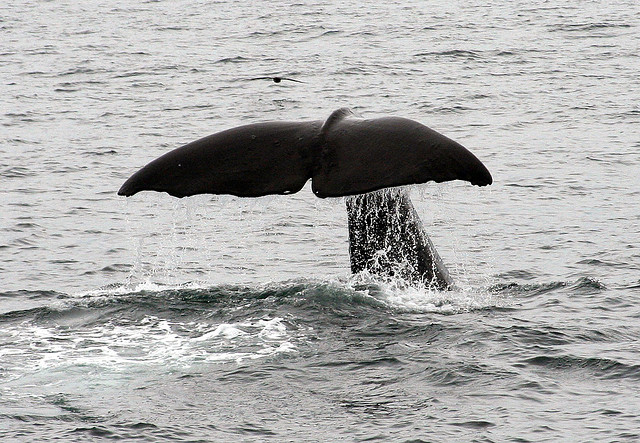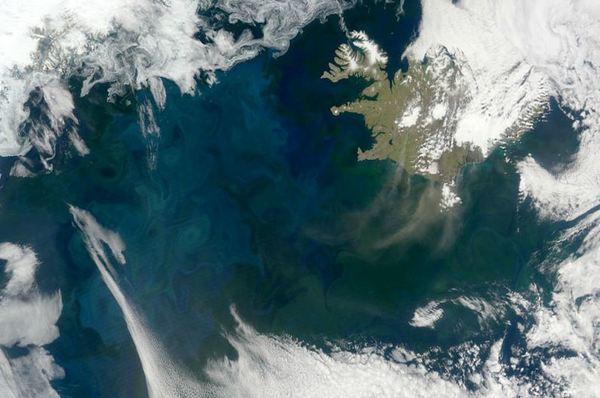
Ocean Mixologists: Animal Movement Key to Sea Life

It's hard not to be moved by the magnificent sight of whales as they hoist their massive frames from the sea and then fall back into the waves with a mighty splash.
But all that splashing is just a fraction of a whale's journey, which is good for more than just show. Underneath the waves, nutrients like nitrogen and iron are moved and mixed around the ocean by the beasts as they surface from hunting in the deep. Contrary to previous belief, whales and other marine animals may play a major role in the worldwide transport of nutrients — from the cold, rich waters of the deep to the warm, nutrient-poor surface. Without these key ingredients, much marine life would cease to exist.
A study published in July in the journal Biogeosciences Discussions estimated that a mere 80 sperm whales that live near Hawaii transport 1,100 tons (1 million kilograms) of nitrogen per year with the movement of their massive bodies through a boundary called the pycnocline, below which it is too dark for light-loving plants — the base of much of the ocean food chain — to survive.
That may seem like an unimpressive amount, but if you take the movement of all the animals throughout the ocean, it can add up. A 2006 study by Florida State University researcher William Dewar calculated that animals and other organisms are responsible for one-third of the mixing of the ocean, without which the sea would stagnate and likely turn into a virtually lifeless soup within a few thousand years. [World's Biggest Oceans and Seas]
Powerful as the wind
If that number holds up, it would make marine animals as important as tides or winds in mixing the ocean, Dewar told OurAmazingPlanet. Scientists had previously thought that only tides and winds moved nutrients around, but more and more evidence suggests life plays a role in shuttling nutrients to keep the system functioning.
The two most important elements, which are abundant in the deep but limited higher up, are nitrogen and iron, which plants need to convert solar energy into energy-rich chemicals like carbohydrates that fuel higher forms of life.
Get the world’s most fascinating discoveries delivered straight to your inbox.
Big animals like whales can transport nutrients with the turbulent wakes created by their movement. But smaller animals like krill likely can move things around too, especially when they move in groups in a uniform "mat," moving down hundreds of feet or meters during the day, and back up again at night.
Groups of krill in the Southern Ocean form perhaps the largest migrating body of animals in the world, said Stephen Nicol, a marine biologist at Australia's University of Tasmania, who wasn't involved in either study. They can move nutrients with wakes from their tiny appendages, but also create a collective updraft (similar to the way a sheet of falling raindrops creates a down-draft), sucking up nutrients.
Animals also make their movements constantly on a daily basis, compared to winds and tides, which often exert most of their influence in large events like storms that occur less frequently.
Efficient mixers
Even tiny animals like grass shrimp are very efficient mixers, said physical oceanographer Claudia Cenedese, at the Woods Hole Oceanographic Institution in Massachusetts. In one study she conducted, a small number of the creatures completely mixed up a large tank filled with separate layers of nutrients in 2-3 days; that's about 100 times quicker than the solution would have mixed on its own via convection and diffusion. (Convection is a pattern of circulation caused by heat; diffusion is the natural process where chemicals spread out from high to low concentrations.)
Animals like jellyfish may also suck up water with them as they go, pulling it into their bodies as they propel themselves.
Tiny plants like phytoplankton, which form the basis of the marine food chain, can only survive near the ocean's surface where light penetrates. When they die, these organisms quickly sink to the bottom of the ocean, taking the nutrients they possess with them. So the ocean needs mixing to survive.
Dewar's 2006 paper, published in the Journal of Marine Research, calculated that worldwide, mixing of the ocean requires 3 terawatts (TW) of power (about one-fifth of the electrical power used by humans each year). Winds, tidal forces and the biosphere contribute about 1 TW of the needed power. These are, however, energetic estimates one step removed from the real world, Dewar said. And that's the problem: in this nascent field, there are few hard numbers to rely upon.
"A lot more work needs to be done to prove this," Nicol said. The growing likelihood that life plays an important role in transporting nutrients doesn't greatly surprise most biologists, he said. "But physical and chemical oceanographers don't like the idea at all and are deeply suspicious of it."

Physical oceanographer Andre Visser, of the Technical University of Denmark, said he thinks that small animals do not mix the ocean significantly, because they are too small. (He also added that the whale study, whose authors could not be reached for comment, was flawed and not well-explained.) Large animals like whales may mix the ocean, he said, but there are too few left to make a big difference. [In Photos: Tracking Humpback Whales]
The nutrient loop
However, Visser said, they probably do play an important role in transporting nutrients in their bodies. Sperm whales, for example, are a classic case—they feed on fish and squid in the deep ocean, and then come to the surface and enrich it with large plumes of nitrogen- and iron-rich floating feces.
Nicol's research on blue whales and fin whales, which feed on krill, has shown the same thing. The fecal nutrients are quickly taken up by blooms of phytoplankton, he said, which are then eaten by krill, functioning like a "living reservoir of iron." More krill means more whales, meaning more nutrients for plankton, which is eaten by krill. And so on.
The contribution of animals to ocean mixing is harder to notice than waves and the movements of the tides, Cenedese said. There are also far fewer whales than there used to be, which has led to less nutrient transport and less-populated oceans, Nicol said.
The idea that animals enhance the movement of nutrients, and help provide more food for the whole ecosystem in a positive feedback loop, is a powerful one with large implications, Nicol said. And it's probably accurate, Visser added.
For one, it would change how scientists formulate models of global climate, ocean circulation, etc. — none of which currently account for animals' roles in these processes, Visser said.
It would also provide more evidence for why it's important to preserve large animals like whales.
How big a role organisms play in the process is impossible to say for now, though, due to the difficulty of making these measurements in the vast ocean and knowing how to average out differences between different locations.
"I can't speculate," said another researcher who has studied the issue of how much animals contribute to ocean mixing, Caltech's John Dabiri said. "It literally depends on how many fish are in the sea."
Reach Douglas Main at dmain@techmedianetwork.com. Follow him on Twitter @Douglas_Main. Follow OurAmazingPlanet on Twitter @OAPlanet. We're also on Facebook and Google+.

